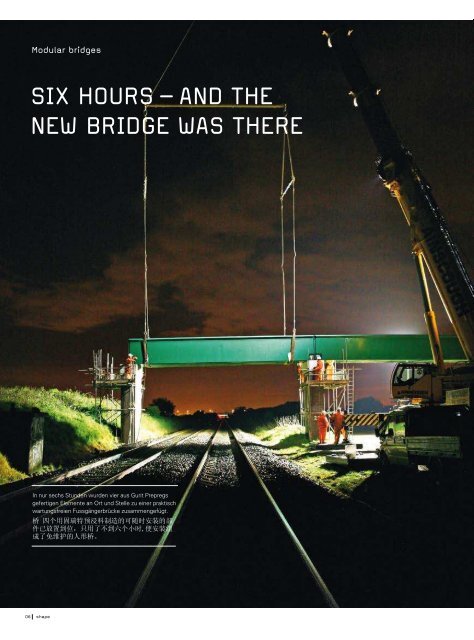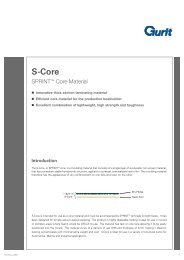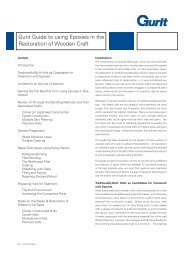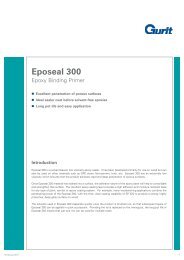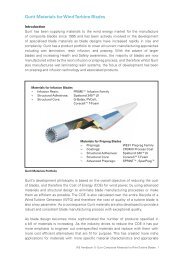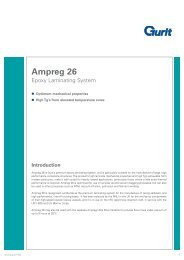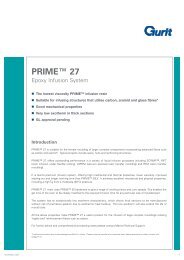Shape - Gurit
Shape - Gurit
Shape - Gurit
Create successful ePaper yourself
Turn your PDF publications into a flip-book with our unique Google optimized e-Paper software.
Modular bridges<br />
Six hourS – and the<br />
new bridge waS there<br />
In nur sechs Stunden wurden vier aus <strong>Gurit</strong> Prepregs<br />
gefertigen Elemente an Ort und Stelle zu einer praktisch<br />
wartungsfreien Fussgängerbrücke zusammengefügt.<br />
桥 四个用固瑞特预浸料制造的可随时安装的部<br />
件已放置到位,只用了不到六个小时,便安装组<br />
成了免维护的人形桥。<br />
The Bradkirk footbridge over the main Preston-Blackpool railway tracks in Britain was<br />
built by a m Structures Ltd on the Isle of Wight using <strong>Gurit</strong>’s composite technology<br />
and materials. The four ready-to-install parts of the bridge were craned into place and<br />
up for years of minimum maintenance service in less than six hours.<br />
Structural composites are increasingly used in construction. They offer<br />
light-weight, corrosion-free and easy to install solutions using offsite<br />
engineered and fabricated elements. Network Rail, the company<br />
owning and operating Britain’s rail infrastructure, was looking for the<br />
most cost-effective way to replace a life-expired steel bridge. The old<br />
structure was comprised of two steel latticework spans resting on<br />
three brick piers.<br />
developiNG a sTaNdardised BridGe desiGN<br />
Network Rail was keen to trial moulded composite technology to develop<br />
a standardised bridge design where the mould could be used<br />
for multiple spans. At first, the plug was produced. This is a singleuse<br />
timber former which serves to form the final shape of the mould.<br />
The mould is then made from glass fibre reinforced epoxy resin and<br />
can be used up to 500 times.<br />
effiCieNT MaNufaCTuriNG TeChNoloGy<br />
The bridge elements – two 12 metre spans and two flights of steps<br />
– were manufactured by a m Structures Ltd on the Isle of Wight.<br />
Each span is a fully moulded composite monocoque sandwich structure<br />
using <strong>Gurit</strong>’s patented s p r i n t ® epoxy technology materials above<br />
and below a structural foam core. s p r i n t ® prepregs consist of a fibre<br />
reinforcement layer on either side of a precast resin film with a light<br />
tack film on one face. Unlike conventional prepregs they remain dry<br />
and offer easy handling until cured. This also gives s p r i n t ® materials<br />
an outstanding breathability and results in autoclave quality laminate<br />
without the expense of using an autoclave.<br />
virTually MaiNTeNaNCe-free sTruCTure<br />
The bridge could have been painted using standard epoxy or polyurethane<br />
paint, yet Network Rail opted for a long-lasting gel coat<br />
finish which gives the best quality finish on the outside, most visible<br />
to the passer-by. Apart from routine inspections and the replacement<br />
of non-slip finishes and stair noses this composite bridge is<br />
practically maintenance-free: the structure is not only corrosion-free,<br />
it features a class 0 fire rating meaning that it is self-extinguishing, is<br />
very tough and resistant to abuse, cracking and chipping. Each 12<br />
metre span is U-shaped with the parapets forming part of the structure.<br />
This shape makes the spans extremely strong and stiff while<br />
they only weigh 1.6 tons each. The light-weight elements could therefore<br />
easily be transported from the manufacturing location on the<br />
Isle of Wight to the final site near Blackpool.<br />
six hours for sixTy years of serviCe<br />
The reconstruction of the Bradkirk bridge was done within three<br />
six hour overnight possessions without disruption of the rail traffic.<br />
The first six hours were used to remove the life-expired steel structure<br />
using an 80 ton crane. In the second six hour interval, new precast<br />
concrete cills and stair landing units were put in place using a 200t<br />
crane. A small 35 ton crane was sufficient for Birse Rail, the principal<br />
contractor of Network Rail, during the third and last six hours in the<br />
night of May 17, 2009 to land the four prefabricated elements precisely<br />
on the spot. Now installed, they will allow pedestrians to safely<br />
cross the railway tracks for the next 60 years at least. For further<br />
information: Thomas.royle@gurit.com<br />
06 shape<br />
The <strong>Gurit</strong> Magazine 05_2009 07


